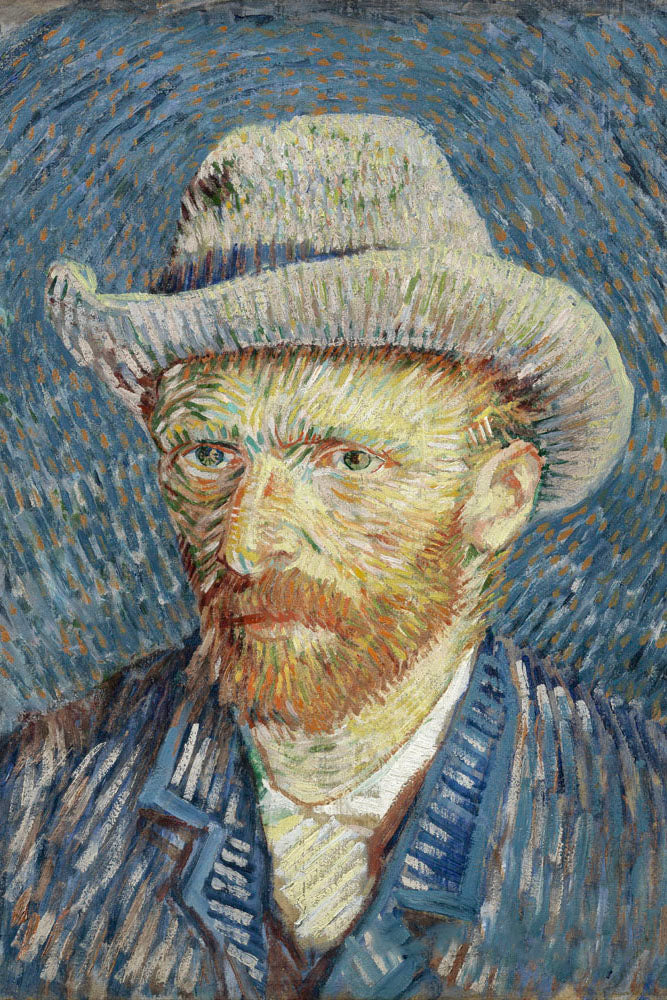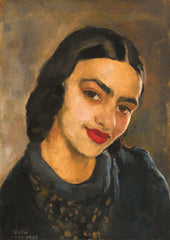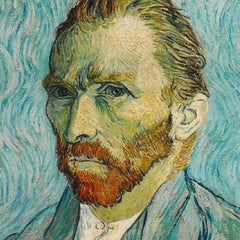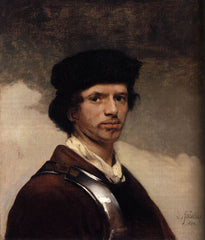Top 7 Vincent van Gogh Paintings And What Makes Them Masterpieces
The son of a pastor brought up in a religious and cultured atmosphere, Vincent was highly emotional, lacked self-confidence and struggled with his identity and with direction. He believed that his true calling was to preach the gospel; however, it took years for him to discover his calling as an artist. Between 1860 and 1880, when he finally decided to become an artist, van Gogh had already experienced two unsuitable and unhappy romances and had worked unsuccessfully as a clerk in a bookstore, an art salesman, and a preacher in the Borinage (a dreary mining district in Belgium) where he was dismissed for overzealousness.
Van Gogh's finest works were produced in less than three years in a technique that grew more and more impassioned in symbolic and intense color, in surface tension, and in the movement and vibration of form and line. Van Gogh's inimitable fusion of form and content is powerful; dramatic, lyrically rhythmic, imaginative, and emotional, for the artist was completely absorbed in the effort to explain either his struggle against madness or his comprehension of the spiritual essence of man and nature.
Between November of 1881 and July of 1890, Vincent van Gogh painted almost 900 paintings. The following excerpts are from letters that Van Gogh wrote expressing how he evolved as a painter. Van Gogh firmly believed that to be a great painter you had to first master drawing before adding color. Over the years Van Gogh clearly mastered drawing and began to use more color. In time, one of the most recognizable aspects of Van Gogh’s paintings became his bold use of color.
Widely hailed as Van Gogh's magnum opus, the painting depicts the view outside his sanatorium room window at night, although it was painted from memory during the day.
Starry Night depicts a dreamy interpretation of the artist's asylum room's sweeping view of Saint-Rémy-de-Provence. An end-of-the-world cataclysm invades Van Gogh's Starry Night, one of apocalypse filled with melting aerolites and comets adrift. One has the impression that the artist has expelled his inner conflict onto a canvas. Everything here is brewed in a huge cosmic fusion. The sole exception is the village in the foreground with its architectural elements. Several months after painting Starry Night, Van Gogh wrote: "I don't know anything with certainty, but seeing the stars makes me dream.”
Blue dominates the painting, blending hills into the sky. The little village at the base of the painting in browns and blues. Even though each building is clearly outlined in black, the yellow and white of the stars and the moon stand out against the sky, drawing the eyes to the sky.
Starry Night is an attempt to express a state of shock, and the cypresses, olive trees, and mountains had acted as van Gogh's catalyst. More intensely, perhaps, than ever before, van Gogh was interested in the material actuality of his motifs as much as in their symbolic dimensions.
Starry Night has risen to the peak of artistic achievements. Although Van Gogh sold only one painting in his whole life, "Starry Night" is an icon of modern art. Van Gogh defined how we see our own age - wracked with solitude and uncertainty.
Van Gogh’s paintings of Sunflowers are among his most famous. He did them in Arles, in the south of France, in 1888 and 1889. Vincent painted a total of five large canvases with sunflowers in a vase, with three shades of yellow ‘and nothing else’. In this way, he demonstrated that it was possible to create an image with numerous variations of a single without any loss of eloquence.
The sunflower paintings had a special significance for Van Gogh: they communicated ‘gratitude’, he wrote. He hung the first two in the room of his friend, the painter Paul Gauguin, who came to live with him for a while in the Yellow House. Gauguin was impressed by the sunflowers, which he thought were ‘completely Vincent’. Van Gogh had already painted a new version during his friend’s stay and Gauguin later asked for one as a gift.
VINCENT VAN GOGH – THE POTATO EATERS
The Potato Eaters, completed in 1885, by many to be Van Gogh's first great work of art. At the time of its creation, Van Gogh had only recently started painting and had not yet mastered the techniques that would later make him famous. Van Gogh saw the Potato Eaters as a showpiece, for which he deliberately chose a difficult composition to prove he was on his way to becoming a good figure painter.
The painting had to depict the harsh reality of country life, so he gave the peasants coarse faces and bony, working hands. He wanted to show in this way that they ‘have tilled the earth themselves with these are putting in the dish they have thus honestly earned their food’. He painted the five figures in the earth – ‘something like the of a really dusty potato, of course’. The message of the painting was more important to Van Gogh than correct anatomy or technical perfection. He was very pleased with the result: yet his painting drew considerable criticism because of the figures full of mistakes. The painting that was completed consisted of 5 figures sitting around a square table eating potatoes; four of them are females and one male. Although the piece is laced in darkness, the mixed emotions residing in the faces of the occupants shine out brightly. The Potato Eaters as one of Van Gogh’s most famous works.
On May 8, 1889, Vincent Van Gogh committed himself to the asylum at Saint Paul-de-Mausole in Saint-Remy, France after many instances of hospitalization and self-mutilation. During his stay, he painted some 130 paintings with the surrounding gardens and his main subjects for painting. Amongst these were the famous The Starry Night and Irises.
Irises are perhaps the first subject he did in the asylum. It preceded his first attack there and at first, glance shows no evident trace of the moodiness and high tension that appear in many of the later works. He paints the flowers with admiration and joy. Inspired by the nature surrounding him, Van Gogh began his work on Irises within the first week of his stay at the asylum. Irises were most likely influenced by Japanese woodblock prints, which were produced beginning in the 17th century. Like many artists of his time, Van Gogh was influenced by Japanese works.
Unlike the Impressionist flower pieces in which the plants are formless spots of color, van Gogh’s Irises are carefully studied for their shapes and individualized, with the same sincerity and precision as Van Gogh's portraits; he discovers an endless variety of curved silhouettes, a new source of movement, in what might easily have become a static ornamental repetition of the same motif. These wavy, flaming, twisted, and curling lines, broken and pointed, anticipate the later works done at Saint-Remy.
Throughout Van Gogh’s career, he painted everything around him: landscapes, people in his town, or even the shoes he wore. In Van Gogh’s Bedroom in Arles, he shows a room in his house. This house, his Studio of the South, was supposed to be the height of his artistic vision. The painting of his bedroom was done with excitement and hope for the future preparing to welcome his friend and fellow artist. Upon entering the room, there is a bed to the right. Along the wall to the right is a chair, a table with water on it, and a window overlooking the street. The wall on the left has another chair and the door to the second bedroom.
Bedroom in Arles shows Van Gogh’s knowledge of color theory with oranges against blues, and reds and greens. Inspired by the Japanese prints that Van Gogh studied, he omitted shadows from the picture. The lack of shadows, along with the distorted perspective, makes some of the objects appear to be failing or not. This is not entirely a result of working fast or a lack of skill. The odd angle of the far wall results in the furniture not aligning squarely.
October 1888, Vincent wrote to his brother Theo describing a painting of his bedroom. Because of the simplicity of the subject matter and items in the bedroom, Van Gogh felt that the color needed to “do the job” of the painting. Van Gogh’s Bedroom, or Bedroom in Arles, painting is of a room where one sleeps, and he wanted the painting to put the viewer’s mind and imagination at rest.
ALMOND BLOSSOMS – VINCENT VAN GOGH’S MASTERPIECE
Van Gogh’s Blossoming Almond Tree also referred to as Almond Blossoms, represents much of what Vincent often thought about: rebirth. Large blossom branches like this against a blue sky were one of Van Gogh’s subjects. Almond trees flower early in the symbol of new life. Van Gogh borrowed the subject, the bold outlines and the positioning of the tree in the picture plane from Japanese printmaking.
The painting was a gift for his brother Theo and sister-in-law Jo, who had just had a baby son, Vincent Willem. In the letter announcing the new arrival, Theo wrote: ‘As we told you, we’ll name him after you, and I’m making the wish that he may be as determined and as courageous as you.’ Unsurprisingly, it was this work that remained closest to the hearts of the Van Gogh family.
Vincent Willem went on to found the Van Gogh Museum. In May of 1890, he was able to leave Saint Paul’s in Saint-Remy and see his family; at this time he brought his painting of the almond tree. Unfortunately, his mental health continued to deteriorate, and he would die less than three months later in the summer of 1890.
Van Gogh had intended to make a nocturnal painting for some time. And not one in a conventional manner, in shades of black and, but actually with an abundance of colors. Equally unconventional is that he paints this gas-lit terrace of a café in Arles in situ and in the dark because colors have a different appearance during the day than by night. Using contrasting colors and tones, Van Gogh achieved a luminous surface that pulses with an interior light, almost in defiance of the darkening sky.
The lines of composition all point to the center of the eye along the pavement as if the viewer is strolling the cobblestone streets. The café still exists today and is a "mecca" for van Gogh fans visiting the south of France. Describing this painting in a letter to his wrote, "Here you have a night painting without black, with nothing but beautiful blue and violet and green and in this surrounding the illuminated area colors itself sulfur pale yellow and citron green. It amuses me enormously to paint the night right on the spot..."
Van Gogh was pleased with the effect: ‘I believe that an abundance of gaslight, which, after all, is yellow and orange, intensifies blue.’ Painted on the street at night, Van Gogh recreated the setting directly from his observations, a practice inherited from the Impressionists. However, unlike the Impressionists, he did not record the scene merely as his eye observed it but imbued the image with a spiritual and psychological tone that echoed his individual and personal reaction. They vibrate with the sense of excitement and pleasure Van Gogh experienced while painting this work.















Comments
JgaQBkCfyxs
iUjOlAJrBQH
kaJBnoyAG
cYSvWsbeXxHGCpo
EXJNTtpxlmFyIuif
smyDRVWNXYaGzdKI
EyarCXTHUA
xEDAbIjwXUkNKZ
CmtxgfRPGXjp
HypMomtIEDSORX